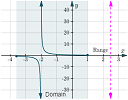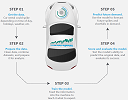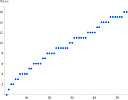IntMath Newsletter: Domain, range, Azure, Riemann
By Murray Bourne, 11 May 2017
11 May 2017
In this Newsletter:
1. New applet: Domain and range exploration
2. Resource: Azure Machine Learning Studio
3. Math in the news: Riemann hypothesis
4. Math movie: Is math discovered or invented?
5. Math puzzles: Bees
6. Final thought: Bees
1. New applet: Domain and range exploration
 |
This interactive applet allows you to explore the concepts of domain and range for several different mathematical functions. Here's the applet: Domain and range exploration And here's some background to it: |
2. Resource: Azure Machine Learning Studio
3. Math in the news: Riemann hypothesis
Cryptography (the science of secret security codes) depends heavily on large primes, and the distribution of those primes is an important consideration for better security.
Mathematicians have tried to approximate the number of primes less than a given large number, and in 1859 the German mathematician Bernhard Riemann conjectured that it was related to the solutions of the Riemann zeta function, ζ(s). This appears to work (and it has been used ever since), but no one has ever proved it.
There's a $1 million prize waiting for anyone who does manage to solve it.
Dorje Brody, a mathematical physicist at Brunel University London has recently come close to doing just that. Their possible solution involves eigenvalues of matrices.
See: New insight into proving math's million-dollar problem
This Prime Counting article gives some good background.
For other unsolved math problems which also hold out the promise of $1 million, see: Unsolved Math Problems from Wolfram's MathWorld.
4. Math movie: Is math discovered or invented?
5. Math puzzles
The puzzle in the last IntMath Newsletter asked how many solutions there were for an inequality.
Correct answers with explanation were provided by Jeel, Sachin, Gerard and Colin, with a variety of approaches used from pseudocode to listing as a group, or counting by one integer (plus/minus) at a time.
New math puzzle: Bees
Female bees have two parents (one male and one female), but the drone (male bee) has only one parent, his mother. What is the maximum number of genetic ancestors a male bee would have in the ninth generation back?
You can leave your responses here.
6. Final thought: Bees
When I was a young boy, my father (a research agronomist) used to get my brothers and me to pollinate some of his experimental plots. We'd place bags over the flowers and shake them, so the pollen would do its magic. I think of that experience whenever I read about bee colony collapse disorder.
In Bee decline threatens US crop production, we learn that each year $3 billion of the U.S. economy depends on pollination from native pollinators like wild bees. As bee population drops, the demand for their services rises.
You can read how differential equations are used to map bee populations in this paper (PDF).
I don't think most of us want to be employed as plant pollinators in the future, and since we like to eat, this is a story that's worth following.
Until next time, enjoy whatever you learn.
See the 6 Comments below.





11 May 2017 at 8:14 pm [Comment permalink]
Let the number of female ancestors n generations back be g(n) and the number of male ancestors be b(n). Now:
g(n)=g(n-1)+b(n-1) [as all bees have a female ancestor in the previous generation] and
b(n)=g(n-1) [as only female bees have a male ancestor in the previous generation].
So, [total number of ancestors n generations back]=g(n)+b(n)=g(n)+g(n-1).
Also, g(n)=g(n-1)+g(n-2) so:
g(n)+g(n-1)=g(n+1) and the g sequnce is the Fibonacci sequence from some offset, as is the total number of ancestors.
We want to find g(9+1) and g(1)=1, g(2)=1 so g(10)=55. Therefore there are at most 55 ancestors in the 9th generation back.
11 May 2017 at 11:27 pm [Comment permalink]
Answer is 142. Start with 1 and follow the Fibonacci sequence of 2,3,5,8,13,21,34 and 55. 55 is the 9th generation. The sum of the 9 generations equals 142. Summing a sequence of the 9 numbers is trivial. To sum a large sequence, go 2 more generations and subtract 2. In this case, the 10th and 11 generations are 89 (34+55) and 144 (55+89). 144-2
= 142. One can write the formula, but first explore the patterns.
12 May 2017 at 4:44 am [Comment permalink]
Looks like the number of females in the ancestry is the Fibonacci sequence starting with the 1 that produced the final male. The number of males is also a Fibonacci sequence starting with the one male that produced the mother of the last male. In the 9 generations before that final male, we end up with 34 females and 21 males. I'm not sure how you wanted the answer to be expressed.
13 May 2017 at 5:47 am [Comment permalink]
I remembered the drones ancestor count was the Fibonacci series (generation 9: 55). Read about it while exploring the sample-models given in NetLogo for Bees and Ant-lines and managed to subsequently (and successfully) amaze myself by reading more about them on Wikipedia etc.
22 May 2017 at 3:57 am [Comment permalink]
Let us tackle this by using a family tree.
Let it be done down the page instead of up.
It had better be a large page.
Then draw it out.
Start with the one male i.e. generation 0
Going back to his mother, a female for first generation back i.e 0 male and 1 female.
Second generation back gives 1 male and 1 female.
Third generation gives 2 males and 3 females.
Fourth generation gives 3 males and 5 females
Fifth generation gives 5 males and 8 females.
This reminds me of Leonardo Pisano Bigollo,popularly known as Fibonacci.
Remember the sequence 0, 1, 1, 2, 3, 5, 8, 13, 21, 34, 55, 89, . . .
Then the number of males would be 0, 1, 1, 2, 3, 5, 8, 13, 21 totalling 54.
and the number of females would be 0, 1, 1, 2, 3, 5, 8, 13, 21, 34 summing to 88
Add the two totals and get 142.
8 Jul 2017 at 3:39 pm [Comment permalink]
I thing the male bee has 33 ancestors in the ninth generation. To arrive at the solution I started with one Male in the 1st generation; the 2nd. gen is 1F; 3rd gen. M-F; 4th gen. F-M-F; 5th gen. M-F-F-M-F, etc.